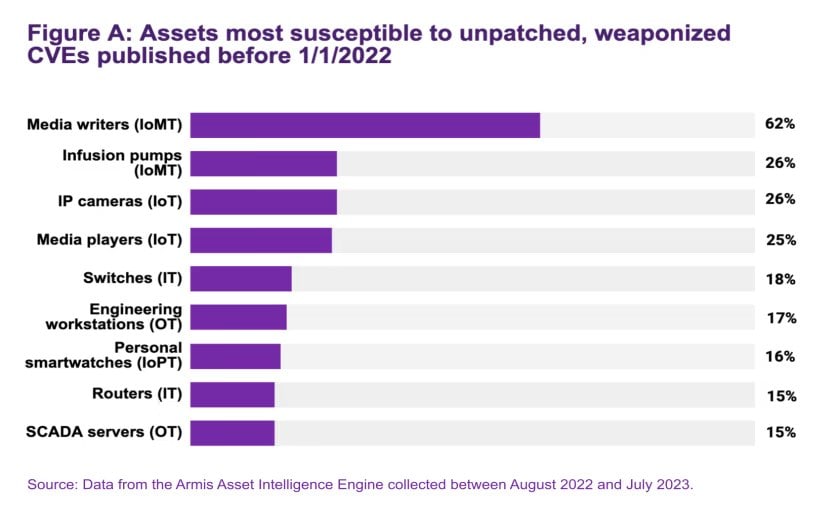The riskiest assets introducing threats to global businesses – Technologist
New research from Armis identified the riskiest connected assets posing threats to global businesses. The findings highlight the risks of being introduced to organisations through a variety of connected assets across device classes and emphasise a need for a comprehensive security strategy to protect an organisation’s entire attack surface in real-time.
“Continuing to educate global businesses about the evolving and increased risk being introduced to their attack surface through managed and unmanaged assets is a key mission of ours,” said Nadir Izrael, Armis CTO and Co-Founder. “This intelligence is crucial to helping organisations defend against malicious cyberattacks. Without it, business, security and IT leaders are in the dark, vulnerable to blind spots that bad actors will seek to exploit.”
Armis’ research, analysed from the Armis Asset Intelligence Engine, focuses on connected assets with the most attack attempts, weaponised Common Vulnerabilities and Exposures (CVEs) and high-risk ratings to determine the riskiest assets.
Assets with the highest number of attack attempts
Armis found the top 10 asset types with the highest number of attack attempts were distributed across asset types: IT, OT, IoT, IoMT, Internet of Personal Things (IoPT) and Building Management Systems (BMS).
This demonstrates that attackers care more about their potential access to assets rather than the type, reinforcing the need for security teams to account for all physical and virtual assets as part of their security strategy.
Top 10 device types with the highest number of attack attempts:
Engineering workstations (OT)
Imaging workstations (IoMT)
Media players (IoT)
Personal computers (IT)
Virtual machines (IT)
Uninterruptible power supply (UPS) devices (BMS)
Servers (IT)
Media writers (IoMT)
Tablets (IoPT)
Mobile phones (IoPT)
“Malicious actors are intentionally targeting these assets because they are externally accessible, have an expansive and intricate attack surface and are known weaponised CVEs,” said Tom Gol, CTO of Research at Armis.
He pointed out that the potential impact of breaching these assets on businesses and their customers is also a critical factor when it comes to why these have the highest number of attack attempts.

“Engineering workstations can be connected to all controllers in a factory, imaging workstations will collect private patient data from hospitals and UPSs can serve as an access point to critical infrastructure entities, making all of these attractive targets for malicious actors with varying agendas, like deploying ransomware or causing destruction to society in the case of nation-state attacks. IT leaders need to prioritise asset intelligence cybersecurity and apply patches to mitigate this risk,” explained Gol.
Assets with unpatched, weaponised CVEs vulnerable to exploitation
Researchers identified a significant number of network-connected assets susceptible to unpatched, weaponised CVEs published before 1/1/2022.
Zooming in on the highest percentage of devices of each type that had these CVEs between August 2022 and July 2023, Armis identified the list reflected in Figure A. Unpatched, these assets introduce significant risk to businesses.
Assets most susceptible to unpatched, weaponised CVEs published before Jan 1 2022

Assets with a High-Risk Rating
Armis also examined asset types with the most common high-risk factors:
- Many physical devices on the list that take a long time to replace, such as servers and Programmable Logic Controllers (PLCs), run end-of-life (EOL) or end-of-support (EOS) operating systems. EOL assets are nearing the end of functional life but are still in use, while EOS assets are no longer actively supported or patched for vulnerabilities and security issues by the manufacturer.
- Some assets, including personal computers, demonstrated SMBv1 usage. SMBv1 is a legacy, unencrypted and complicated protocol with vulnerabilities that have been targeted in the infamous Wannacry and NotPetya attacks. Security experts have advised organisations to stop using it completely. Armis found that 74% of organisations today still have at least one asset in their network vulnerable to EternalBlue – an SMBv1 vulnerability.
- Many assets identified in the list exhibited high vulnerability scores, have had threats detected, have been flagged for unencrypted traffic or still have the CDPwn vulnerabilities impacting network infrastructure and VoIPs.
- Half (50%) of pneumatic tube systems were found to have an unsafe software update mechanism.